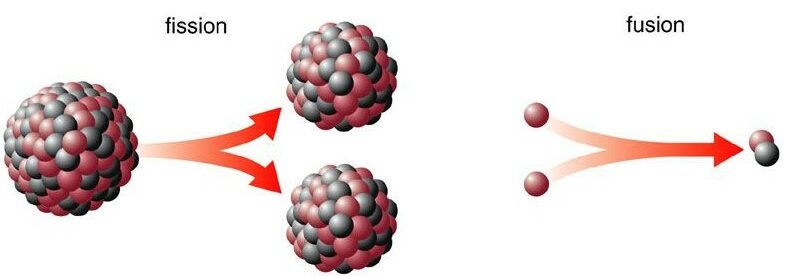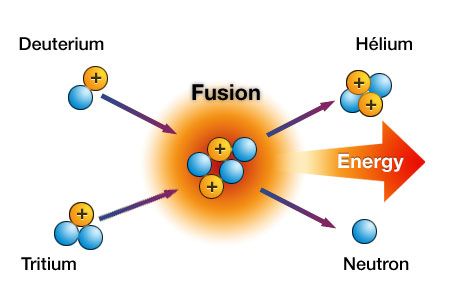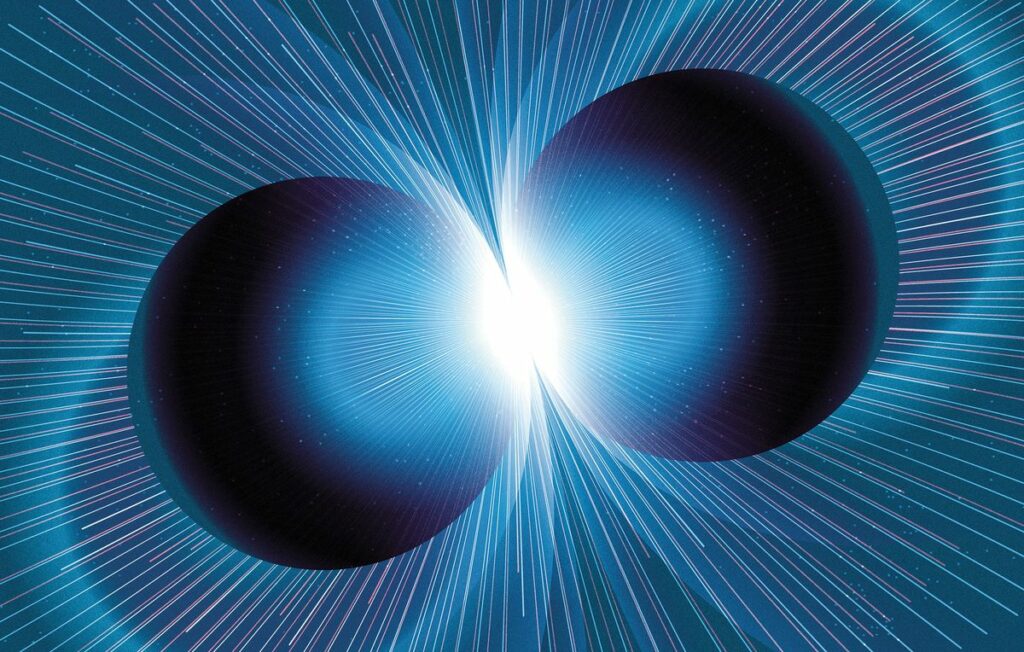The fundamental of nuclear energy is harvesting the power of atoms. Nuclear fusion and fission both are nuclear processes, and atoms are altering to others to create energy. The difference between them is the nature of the reaction. Fission is the split of one atom into two, and fusion is the combining of two lighter atoms into one larger atom. And to say simply, they are opposing processes and are different in that way.
Differences Between Nuclear Fusion and Fission
Fission and fusion both are nuclear reactions and produce much energy, but their applicability is not the same. Fission is the splitting of an unstable and heavy nucleus into lighter nuclei, while fusion is the process of combining two light nuclei for releasing large amounts of energy. Because easy-controlling fission is used in nuclear power reactors, fusion is not employed to produce energy since the power is not easily controlled and is expensive to develop the required conditions for a fusion reaction. Fusion experiment stages are just started, and there is a long way to achieve what we need.

Nuclear fission
The word fission means splitting and breaking up into many parts, and nuclear fission means the release of heat energy by splitting atoms. The discovery of nucleus division is based on Albert Einstein’s prediction that claimed the conversion of mass into energy. In 1939, researchers and scientists began experiments, and about one year later, the first nuclear reactor was built by Enrico Fermi.
Nuclear fission happens when a large and unstable isotope is bombarded by high-speed particles, the same as neutrons. Atoms with a different number of neutrons but the same number of protons are called an isotope. Neutrons are accelerated and have a collision with the unstable isotope, and that is how fission happens, breaking the large atom into smaller particles. Along the process, neutrons are accelerated and strike the target nucleus of isotopes. Today in almost all nuclear power reactors, the fuel is Uranium-235, which is unstable. After division, the core breaks down into three high-speed neutrons, two smaller isotopes (the fission products), and a large amount of energy that we harness. The released energy is used to heat water in the reactor and to produce electricity. Three neutrons have become high-speed projectiles that start other fission reactions and chain reactions for more income energy.
Nuclear Fission Reactor
Many reactor features are designed to manage the reaction’s speed and the temperatures inside the shieldings. An unlimited fission reaction is the source of an atomic weapon. Fission reactors contain different parts as listed below:
Coolant
We use a coolant for absorbing released heat from the fission reactor. It should have good conductivity. In the second step, this coolant boils the water for providing steam and the force of moving turbine blades.
Concrete Shield
Products of the fission reaction are radioactive, the same as the waste, which is kept carefully. So we need a shield to assure of being safe.
Nuclear Fuel
The plutonium or uranium isotopes are split into products and produce energy in the reactor, and it is all initiated by an incoming neutron. The fuel is contained in rods so that the released neutrons from one rod would fly out and start nuclear fission in other rods.
Moderator – Graphite Core
Usually, a graphite-based core regulates the neutrons down to be more assured to be absorbed in nearby fuel rods.
Control Rods
We use control rods and raise and lower them in the reactor to stop neutrons from moving between fuel rods and, consequently, change the speed of the chain reaction.

Read More On Linquip
- How Does Nuclear Fusion Work?
- What Is Nuclear Fission?
- What are the Disadvantages of Nuclear Fusion?
- Types of Nuclear Reactors: Differences and Operation Principles
- Difference between Kinetic Energy and Potential Energy
The Advantages of Nuclear Fission
Nuclear fission happens through two processes: It is either a radioactive decay or a nuclear reaction. These processes cause the nucleus of an atom to split into some smaller parts and create free neutrons and gamma protons as a production of a reaction. At the same time, a large amount of energy is released, which can be captured or converted to other energy types.
Cheap Energy Resources for the Planet
Currently, nuclear fission is responsible for more than 10% of the electricity consumed on the planet. More than 30 countries use nuclear fission forms of energy at some level to create the electric power that is necessary for the modern lifestyle and industries. There are other forms of energy available, but nuclear fission energy is one of the cheapest.
Low-emission Energy Solution
Most of the forms of traditional power generation need fossil fuels to be combusted. Combustion and power plants release toxic particles and gases into the environment that offer potential events with harmful effects. From air quality concerns to global warming, all are essentially not concerned anymore when nuclear fission is used instead of combustion as there is no CO2 released.
Time of Working
A nuclear fission reaction in a well-controlled condition can produce energy for two or three years. To create the same amount of energy, fossil fuels would need to be consumed very fast, which is not possible. The efficiency of Nuclear energy is 8,000 times more compared to coal or wood heating.
Reliable Source of Energy
The current nuclear fission power plants are designed to operate for half of a century. Also, there is enough uranium stockpiled globally to produce energy resources for another century while we still mine and refine more.
High Concentrations of Energy
Nuclear fission provides a large amount of energy from a small mass of fuel. The concentration of power in small mass is required, eliminating the necessity of reserving products or stockpiling fuels to maintain power.
The Lowest Annual Mortality Rate Among Others
According to Forbes, the global average mortality rate for nuclear fission is about 90 deaths per trillion kilowatt-hours. Wind power is a renewable energy resource, and it has 150 deaths per trillion kilowatt-hours. For other renewable energy such as rooftop solar energy, the mortality rate is 440 deaths per trillion kilowatt-hours. The global average is 170,000 deaths per trillion kilowatt-hours, but as we remove China from the list, the numbers for coal would be 20,000.
Low Ongoing Operational Costs
The ongoing production rates are similar for nuclear fission, solar, and wind energy. It is one of the cheapest and most effective forms of energy after starting to operate.
The Disadvantages of Nuclear Fission
Although nuclear fission energy is cheap and clean, it has some disadvantages listed below:
Highly Dangerous
All we remember of tragic events such as Fukushima and Chornobyl showed us how dangerous is the process of nuclear fission. In July 2017, robots found melted nuclear fuel underwater. All these events create radiation exposure that can be dangerous to all human and animal health.
Explosive
It is right that nuclear fission can be the foundation of clean and cheap energy, but it can be the foundation of powerful weapons, which are responsible for mass casualties. The atomic bombs were dropped on Japan leaving about 226,000 dead people in four months and it all started with the fission reaction. This means fission technology is a real threat to the planet.
Harmful Waste Products
This type of energy is clean-burning, but we should be aware of the radioactive waste products, which can be very harmful to all humanity and the environment. Toxic waste can damage a regional environment for hundreds of years without proper disposal sites.
Long-term Health Issues For All the Living
Disease and health concern issues can be developed because of radioactive waves and nuclear fission reactions, or waste exposure. Cancer is one of the most common concerns that can develop and not being able to be cured.
High Start-up Costs
The start-up cost for a new nuclear plant rose from $2 billion to $9 billion per unit from 2002-2008 and the United States. It is the same in Canada and Europe and even higher. As discussed before, it would be cost-effective after being online and providing power for a minimum of 50 years.
Nuclear Fusion
The exact meaning of fusion is the merging of different elements into one whole unified unit. When two isotopes with low mass unite at extremely high temperatures and pressure, fusion occurs. Usually, hydrogen isotopes are utilized in reactors.
Nuclear fusion happens in the sun and powers it. Isotopes of hydrogen, Hydrogen-3, and hydrogen-2 deuterium, which is called simply Tritium and Deuterium, unite at an extremely high temperature and pressure, and the production is helium isotope and neutron. The amount of energy released in this reaction is several times more than fission.
Scientists and researchers work on controlling and manipulating nuclear fusion energy and reaction to make fusion reactors provide electricity for facilities. Some of them believe that it is an opportunity for us to use such a power source since nuclear fusion creates weak radioactive material compared to fission and has nearly unlimited fuel. Nevertheless, progress is heavy due to challenges in explaining how to manage the reaction in an included space.

Advantages of the fusion
The next decades are crucially essential to put the world on a path of reduced greenhouse gas emissions. By the end of the century, energy demand will have tripled under the combined pressure of population growth, expansion, and increased urbanization access to electricity in developing countries. The fossil fuels that shaped 19th and 20th-century civilization can only be relied on at the cost of pollution and greenhouse gases. A new large-scale, carbon-free, and sustainable type of energy is urgently necessary. The following advantages make fusion worth pursuing to use:
Abundant Energy
Fusing atoms in a chain in a controlled way produces nearly four million times more energy rather than a chemical reaction such as the burning of gas, coal, or oil, and four times more than nuclear fission reactions at an equal mass. Fusion can provide the base load energy required for providing electricity to cities and industries.
Sustainability
Fusion fuels using in for providing energy are widely available and nearly inexhaustible. For example, we can distill Deuterium from all forms of water; on the other hand, tritium will be produced during the fusion reactions as fusion neutrons interact with lithium. We can use terrestrial reserves of lithium, this would permit the operation of fusion power plants for more than thousands of years, and sea-based reserves of lithium would satisfy needs for millions of years.
No CO₂
Fusion doesn’t release harmful toxins like carbon dioxide or other types of greenhouse gases into the atmosphere. Its major by-product is inert and non-toxic helium.
No long-lived Radioactive Waste
Nuclear fusion reactors produce no long-lived and high-activity of nuclear waste. The activation of fusion reactor components is low enough for the materials to be reused within 100 years.
Limited Risk of Proliferation
Fusion doesn’t use fissile materials like uranium and plutonium, and radioactive tritium is not a fissile or fissionable material. There are no enhanced materials in a fusion reactor like ITER that could be utilized to make nuclear weapons.
Risk of Meltdown
Nuclear accidents, same as Fukushima, are not possible in a fusion device. If any disturbance occurs in a reactor, the plasma cools immediately, and the reaction stops. The amount of fuel in the vessels is enough for a few seconds only, and there are no risks of happening chain reactions.
Cost
The power outputs in the fusion reactors that are envisaged for the near future will be similar to a fission reactor (for example, near 1 and 1.7 GWatts). The average cost of electricity per kilowatt is expected to be the same or slightly more expensive at the start because of new technology. It would be less expensive as economies of scale bring the costs down.
Disadvantages of Nuclear Fusion
Nuclear fusion is a clean type of energy all countries looking for, but there are lots of barriers in the way of achieving this valuable source of energy.
Comparison of Energy Input and Energy Output
We need very high levels of heat to fuse the two nuclei and make a new one. This reaction demands a large amount of power at the start, approximately as much as the energy it will be returned. As a result, nuclear fusion is truly not probable.
Expensive Construction Costs
The equipment, specialists, and whatever relates to nuclear fusion that is needed to run a nuclear fusion reactor successfully and plant are very expensive. Besides these high costs, it also requires quite a pretty penny to harness the produced energy.
Little Knowledge
This type of energy is quite new and needs much effort to reach large-scale production. The full expanse of threats and consequences of nuclear fusion power isn’t understood, and it is all because of not being around long enough.
Materials of The Job
The most critical problem of nuclear fusion is the material of operation. As we know, there is no a material to endure the extremely high heat of the reaction. So, there is no future for the energy source until scientists can find something that can bear high temperatures.
Buy Equipment or Ask for a Service
By using Linquip RFQ Service, you can expect to receive quotations from various suppliers across multiple industries and regions.
Click Here to Request a Quotation From Suppliers and Service Providers
Read More on Linquip



